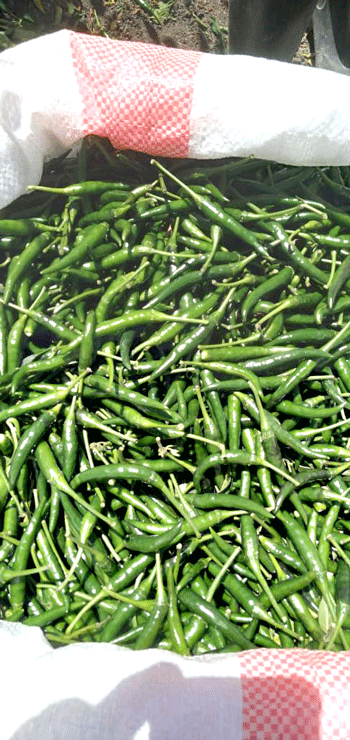
Karen Nduku narrates her Chili Farming journey
Chili is increasingly becoming one of the hottest crops for farmers and a household ingredient in Kenya. They are grown mostly for their fresh fruits used to flavor soups and stews and for seasoning and making sauces. In the picturesque landscapes of Mwala, in Machakos County, Hortfresh Journal crew meets a vibrant spice lover who has turned her passion into agri-business. Karen Nduku is cultivating the Demon F1 and Cayenne varieties of chilies not only in Machakos County but also in Kajiado County. A farmer and agronomist, now grows over ten acres of chilies and is training other farmers to do the same as a way to protect their incomes in the face of harsher weather linked to climate change.
Speaking to her, you can comprehend that what she utters is entire wisdom. Her passion in chili farming is drawn from the resources that were available to her. She had huge chunks of land for cultivation as well as a seed capital which she had saved form her income.
She narrates her Chilies farming journey and the experience she has gained and how the market for chili is.
I would say I am a foodie; I love to cook. Before I used to plant chilies on small scale for my own consumption. While interacting with one of my friends who is an agronomist, I came to learn more about the insatiable demand of chili in the export market especially in the UAE. I did my own research and discovered exporters were in search of the crop. I also read an article on the BBC which opened up my mind about chili farming.
Hot and humid weather is very suitable for the cultivation of the crop. Cool, wet weather reduces growth and the plants become more susceptible to disease attack. Temperature should be in the range of 22 °C to 35 °C for good chili production. The sandy loam, loam and clay loam soils are good for chili cultivation. The soil should be well drained and aerated as it gives a better yield.
It has been an interesting farming journey since I planted my first crop because it has been one revolving around learning. One of my biggest lesson I have learnt which I always tell people who are envisioning joining farming, is try and figure out your market fist before venturing into any farming activity. This helps because you will always have a fall back plan when you harvest your crop.
I sells each kilo at Ksh80 when there is low supply in the market and low as Ksh50 when there is a market glut hence giving me some good returns all together. A well-maintained crop should be able to produce up to 3 tons of chili per acre.
One of the things I have come across while farming chilies organically is that there is a notion that organic food is very expensive thus making it to be a preserve for the wealthy. This is not right and we should debunk this myth. Organic food should be not be ‘premium’ and that thinking for me is faulty; everyone should have access to affordable organic food.
Organic farming is one area that has been neglected especially by the government. We have a very big issue when it comes to MRLS in the export market. For one to access this market you need a produce which is free from chemicals.
I have visited several farmers in Kajiado County and the chemicals they were using on the crops, the fertilizers and the fungicides left me heartbroken. I had a chat with one of them and he alluded that the government and other institutions sometimes give them for free to enhance their farming, while they get others at a relatively cheaper price from the neighboring country.
Farmers in Mwala have benefited from the Kenyan government partnering with the Africa Development Bank (AFDB) by establishing the Kabaa Irrigation Scheme to boost food security and curb perennial hunger in the drought-prone Eastern Kenya. The project under Small-Scale Horticulture Development Projects (SHDP, covers about 240 hectares with variety of crops under cultivation. The project which is one of the nine irrigation schemes in seven counties of Arid and Semi-Arid areas cost of 22.8 million U.S. dollars.
For a successfully chili farming the first key element is water; the more the water the plant receives the firm and strong the fruit develops. Having a good water source is ideal because chilies consume a lot of water. Secondly, you have to incorporate fertilizer or manure and for us we use a mixture of goat and cow manure. In addition we have a foliar that is rich in potassium. Potassium plays a major role in plant health, helping to create sturdy stems, aiding photosynthesis and aiding disease resistance. Farmers need to ensure they have the right seedling without that you are off on the wrong course.
When venturing into chili farming, the bigger the project the more cost effective it is. Unfortunately, I won’t advise farmers to venture into it that way. The safer approach could be have a half an acre on chilli, monitor the crop, get to learn the ropes, study the challenges and grow with the crop. Once you have mastered the craft, expand.
For starters kindly check the kind of soil you have and the region you are farming. Unfortunately cooler places are not favorable for farming the crop. For our future, we are hoping to expand. We have managed to streamline our workers and we have systems in place and God willing we would pursue value addition.



